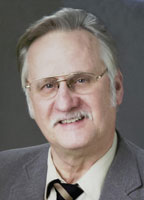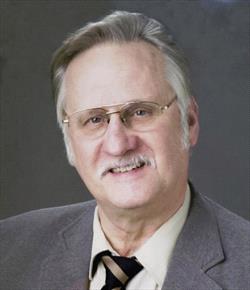
William E. Blevins

Purdue University photo
William E. Blevins, DVM, MS, DACVR, is a past president of the American College of Veterinary Radiology.
While I was on a Boy Scout trip to Florida in 1957, the Soviet Union launched Sputnik. Little did I realize what a profound effect that event would have on my future profession. It ushered in the era of the spy satellite. What does that have to do with veterinary radiology, you may ask.
During the time of Sputnik and the few years that followed, the U.S. government made use of high-resolution images of sensitive global sites. We spied on the Soviets; they spied on us. Those early images used high-resolution film. At that time, film was chemically developed, which meant that capsules containing film had to be sent back to Earth for processing of images. Because of the sensitive nature of those images, the film could not fall into just anyone’s hands. A system was developed whereby the capsule and its parachute could be snatched out of the air by airplane. This method was cumbersome. Something was needed to improve the situation. Digital imaging was developed in response to this need, and that changed everything.
It would be about 40 years before digital imaging was used in veterinary medicine. Initially, the images were not very good. They have since improved to become highly useful diagnostic tools that can be sent over the internet with ease and precision.
Early on, the practice of veterinary radiology as a specialty was the province of academia. College campuses were where most radiologists plied their skills, and where new radiologists were trained. Because digital imaging has provided multiple opportunities for radiologists in the private sector, there has been a shift of radiologists’ activity from academia to the private sector. This has created a dearth of radiologists to do the training in academia, where most of the training of new radiologists occurs. However, it is not the only factor that has affected academic radiology in veterinary medicine.
Private radiology practice as a viable alternative
In the late 1960s and early 1970s, a few academic radiologists migrated to private practice: Drs. Jim Ticer, Bob Barrett, Ralph Slusher, and Juan Gomez. Others followed in the late 1970s. These pioneers had difficulty financially because the only way they could earn money as a radiologist was through interpreting radiographic images and performing special radiographic procedures. There was a low demand for these skills at the time so they incorporated general practice into their daily work.
By the late 1970s and early 1980s, computed tomography and the industry giant, diagnostic ultrasound, entered the veterinary market. Private imaging practice began to soar and became an attractive alternative to newly trained radiologists. This increased the rate of migration of academic radiologists to the private sector. At an American College of Veterinary Radiology (ACVR) meeting in the mid 1980s, the agenda included a panel discussion about private radiology practice. This gave guidance to other radiologists who were becoming disenchanted with academic radiology.
Private consulting while in academia
While a member of the faculty at Purdue University School of Veterinary Medicine, I began consulting privately in 1974. The university approved this practice, and initially I was allowed two days per month for private consulting. Eventually, that increased to four days per month. This policy was the norm throughout the university. Many other universities followed this practice; some did not. The University of Minnesota developed a collaborative program whereby the university shared the income with the radiologist and provided secretarial support. Private consulting in academia was a win-win situation. The consultation not only allowed me to keep pace financially with my private-practice colleagues, it brought real-world cases to the classroom and kept my perspective as a teacher in line with what my students would face in practice.
In more recent times, deans of veterinary schools have disallowed private practice consulting. I am aware of three radiologists who left Purdue when consulting was eliminated. Three radiologists left the University of California, Davis, School of Veterinary Medicine for the same reason. Not only were those academic radiologists lost to the institution, but the private-sector perspective was lost to the institution and to its students, as well.
College debt adds to financial pressures
When I was in veterinary school (1964-1968), two-thirds of the university’s budget was supported by the State of Indiana. Now, the state supports less than 5 percent. Most of us in veterinary medicine are painfully aware of the rising cost of higher education. Tuition and fees have been and are increasing more rapidly than the cost of living. Some graduating veterinarians incur $150,000 to $250,000 in college debt. Those U.S. students who matriculate in foreign schools accrue even higher debt on average.
To become a radiologist, a one-year internship and a three- or four-year residency are required. Interns and residents are paid relatively little, so they are unable to significantly pay down their debt while training in their specialty. When new radiologists come out of the training pipeline, they have huge debt. They need to make money. The large incomes are in the private sector. A new radiologist can make $250,000 the first year. Inevitably, this suppresses the number of radiologists entering academic positions, where the starting salary averages $125,000 (highest to my knowledge is $180,000).
Corporate veterinary medicine tips the scales
The rise of large corporations in veterinary medicine has had a major impact on the practice of veterinary radiology. When I entered radiology in 1968, all of the “toys” (i.e., sophisticated equipment) were in academia. There was even some concern in the 1970s that too many radiologists were being produced. The thinking at the time was that the only real position for a radiologist was in academia.
During the late 1980s and 1990s, the concern shifted. It became more difficult to find academic radiologists, so the impression was that we were not producing enough radiologists. Deans would argue that academia had benefits (retirement funds, paid vacation, etc.). Corporate smiled and said, “So do we.” But, the universities countered, academia has better equipment. Corporate smiled and said, “We have state-of-the-art digital imaging, ultrasound, CT, MRI and scintigraphy.” From a professional perspective, there was no compelling reason to enter academia except to teach or do research.
In corporate practice, there is no publish-or-perish paradigm, no committee service, more flexible hours, full employee benefits, and — especially — better income. Toward the end of my academic career while in a staged retirement program, I could earn in two days per week at a private specialty practice what I was making full time at the university.
There are downsides to corporate practice, of course. These include the notion of “production-based income.” This causes some disagreement between the specialists about who gets the production credit, and therefore the income, for a case. Also, in my opinion, there seems to be less loyalty between employee and employer. In corporate practice, they can let you go in a matter of days or weeks. In academia, usually a one- or two-year phaseout is used, depending on the contract.
Tele-imaging opens a new frontier
Tele-imaging — providing interpretation of images over the internet — has provided opportunities for radiologists to generate income from the comfort of their own homes. The first commercially available tele-radiology system for use in veterinary medicine was sold by Professional’s Software Inc. (PSI) of Effingham, Illinois, in 1994. Practicing tele-imaging is an especially flexible activity and is most attractive to radiologists who have families needing attention. Multiple tele-imaging services exist in the profession, run by individuals or companies large and small.
The budding crisis
Any species, organism, organization, or specialty eventually will die if it does not reproduce itself — or adapt to changed conditions. Currently, veterinary radiologists are primarily trained in academia. With a dwindling supply of academic radiologists, residency programs are in jeopardy. At present, there are three veterinary schools that do not have a trained, ACVR certified radiologist on staff. Their residency programs have been discontinued.
There are other academic programs that are understaffed with radiologists. Currently, for a residency program to be approved by the ACVR, it needs two ACVR or ECVDI (European College of Veterinary Diagnostic Imaging) radiologists to be actively involved in the program. Some universities have only one ACVR radiologist. At these locations, there cannot be a residency program. The ACVR is struggling with developing residency programs in private practice. Non-academic programs will have to be developed if veterinary radiology is to survive as a specialty long term.
Unlike other specialties, the field of veterinary diagnostic imaging has a unique opportunity to train potential radiologists over the internet. The very circumstance that has threatened our specialty by providing opportunity outside of academia — digital imaging — also provides an opportunity to use this technology to help expand our ranks.
A radiologist who left academia once told me: “The degree to which you are missed in academia is equal to the hole your hand leaves when you pull it out of a bucket of water.” Although this comment is a bit cynical, there is a lot of truth to it. When no radiologist is available, other specialists do their own imaging. We’ve seen this happen in other specialties. When I was in veterinary school, we had a course in avian pathology. That course no longer exists. Currently in poultry production, there are almost no positions for veterinarians. Animal scientists have taken up the slack because we, as a profession, did not produce enough veterinarians with poultry interest.
Artificial intelligence is being developed for diagnostic imaging in veterinary medicine. There is one tele-imaging service that is distributing software that will pre-read images and indicate regions of alteration. Other companies are working on developing this technology. The impact this technology will have on the interpretation of veterinary image diagnosis is unknown.
Academic radiology and the ACVR are not yet ready to implode, but there are early indications that the dwindling supply of academic radiologists will have a negative effect on this specialty if not corrected. In 1999, the ACVR devoted a major portion of its annual meeting to the issue of the dwindling numbers of academic radiologists. Nearly 20 years later, the ACVR has not embraced a program to address the issue. Each year, we wring our hands and discuss the problem, but nothing of significance has been done.
Acknowledgement: I would like to offer a special thanks to Dr. Jerry Owens for some of the historical information.
About the author: William E. Blevins, DVM, MS, DACVR, earned his veterinary degree from Purdue University in 1968 and master's degree at Iowa State University in 1970. At that time, there were no residency programs in radiology. An MS degree was required to sit for the American College of Veterinary Radiology certification exam. Blevins became a diplomate of the ACVR in 1973. He is a past president of the ACVR and has served on many of their committees. He also is a past president of the Veterinary Ultrasound Society.
Blevins currently is a professor emeritus of diagnostic imaging at Purdue University College of Veterinary Medicine. Joining the university in 1970, he served as head of the Diagnostic Imaging Section for 37 of his 39 years on the faculty. Blevins joined the Veterinary Information Network in 2000 and has served as an editor and consultant in the Diagnostic Imaging Folder.